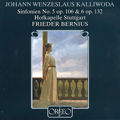ORFEO International – Catalogue
CDs
Meisterschaft in harmonischer wie formaler Gestaltung

Johann Wenzeslaus Kalliwoda (1801–66) is only one of many composers whose works, long undervalued and rarely performed, have been revived in modern times thanks to recordings such as those of the Stuttgart Hofkapelle under its conductor Frieder Bernius. By bringing out their striking tone colours and adopting a highly flexible approach to their dynamics, while taking full account of the composer’s stylistic idiosyncrasies, the performers ensure that the special qualities of these symphonies are clear at the very first hearing.
The Bohemian-born Kalliwoda was no innovator and, unlike such slightly younger colleagues as Mendelssohn and Schumann, he did not revolutionize symphonic form. But nor did he allow himself to be intimidated by the all-powerful shadow of Beethoven when venturing into the field of the symphony. Even the beginning of his Fifth Symphony in B minor, with its gradual entry of the instruments building to a flowing cantilena and contrasting with fanfares in the horns and trumpets, reveals a style of writing as original as it is compelling.
Kalliwoda’s art of instrumentation emerges in the later movements, turning them into regular character-pieces and even recalling Berlioz, while at the same time refuting the claim that during the quarter of a century that Kalliwoda spent as Kapellmeister to the house of Fürstenberg in Donaueschingen, he slowly drifted away from mainstream European music.
Kalliwoda’s Sixth Symphony – his last contribution to the medium – is in F major and abounds in elaborate transitions and a sophisticated use of variation technique. In the meticulously articulated and phrased performance by Frieder Bernius and the Stuttgart Hofkapelle, the work emerges as Kalliwoda’s tribute to Beethoven, Schubert and Spohr rather than as a forward-looking piece in the Schumannesque tradition, for all that Schumann repeatedly expressed the greatest respect for its composer.
|